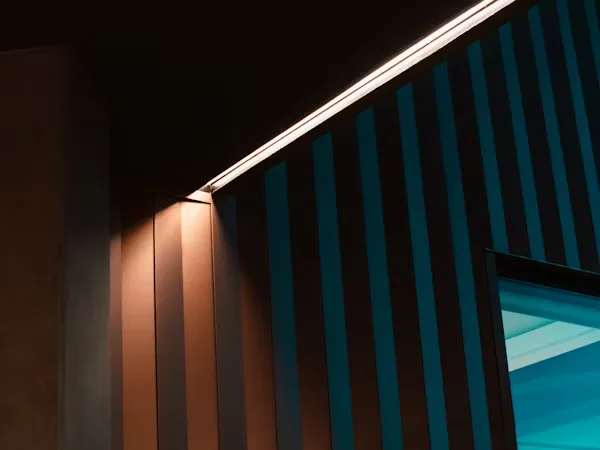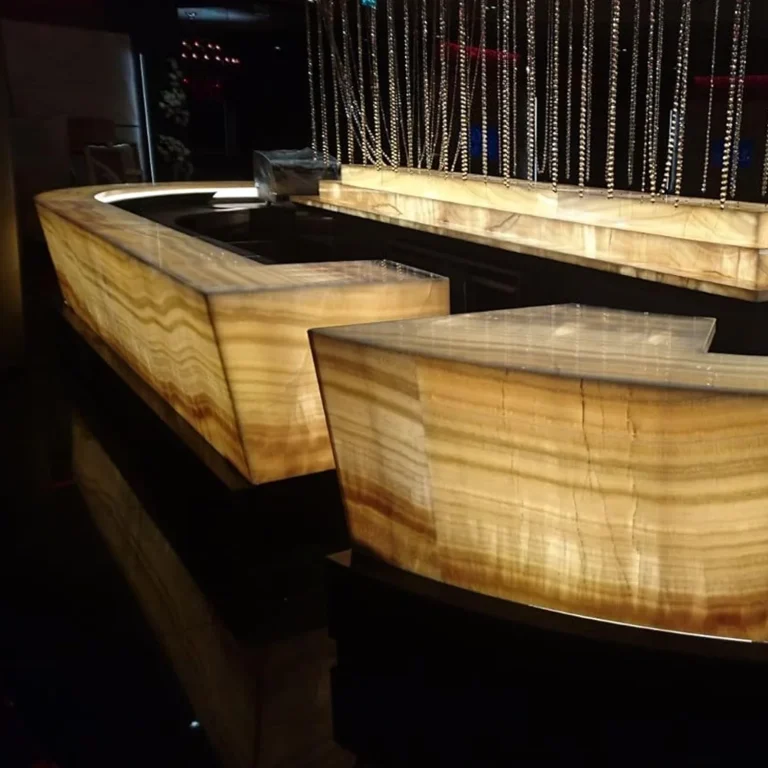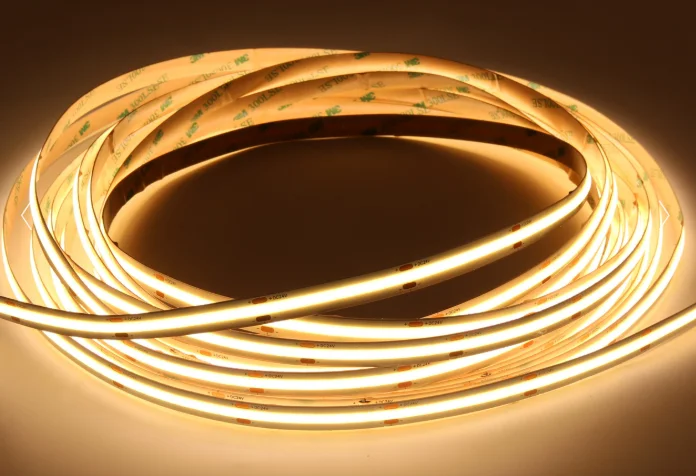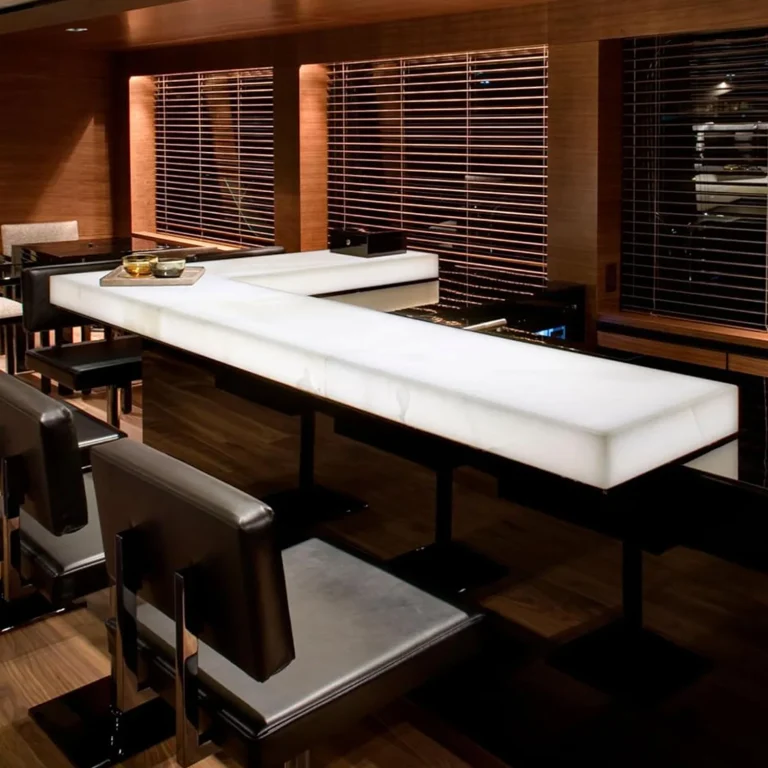Adding LED strip lights around your fireplace makes a super cozy and cool vibe. They save energy and look awesome. But picking the right ones isn’t just about colors or brightness. You gotta think about fire safety and toughness, too. Nobody wants lights that could be dangerous near heat. This guide shows you how to pick fire-resistant LED strip lights for your fireplace, keeping things safe and stylish.

Why Fire-Resistance Matters for LED Lights in Fireplaces
High-Temperature Conditions in Fireplaces
Fireplaces get super hot. Even new gas or electric ones make the area around them toasty. Old-school lights like bulbs give off too much heat and aren’t safe. But LED strip lights, if you pick the right kind, are safe and last a long time. Fire-resistant LED strips are made to handle hot spots. They won’t melt or break wires even at 100°C (212°F). That makes them perfect for near or inside your fireplace.
Safety Considerations for Homes and Businesses
Safety comes first for homes and shops. Lots of LED strip lights aren’t built for super hot places. Using regular ones near a fireplace could be risky. They might overheat, short out, or worse. Picking LED strips with UL, ETL, or TUV marks means they’ve passed tough safety checks. These prove the lights are safe for fire risks, electric stuff, and work great in hot spots.
Key Criteria When Choosing LED Strip Lights for Fireplaces
Temperature Rating & Fire-Resistance
Pick LED strips that can take high heat when shopping for your fireplace. Look for ones that handle 85°C to 100°C (185°F to 212°F). These won’t break in hot areas. Strips with fire-resistant coats and heat-proof backs are key for staying tough and safe. Make sure the lights are rated for both heat and fire safety. Stuff like silicone or strong PCB boards helps avoid heat damage. For fireplaces, check if the strip has a fire-stopping coat. This lowers the chance of catching fire if it gets near flames.
Waterproof & IP Ratings
Wood-burning fireplaces can get smoky or damp, which can hurt lights if they’re not protected. For spots like mantels or floors near the fire, grab waterproof LED strips with at least an IP65 rating. IP65 means the strips block dust and can handle water splashes. They’re great for humid places or areas near kitchens, bathrooms, or fireplaces in wet climates.
Color Temperature & Brightness
The right light color sets the perfect fireplace mood. Fireplaces give off a warm glow, and LED strips can match that with adjustable colors. For a snuggly, cozy feel, pick strips with 2700K to 3000K. These look like real fire flames, giving a soft, friendly light. For a modern twist, RGB LED strips let you change colors for fun effects.
Certifications & Safety Standards
Safety is a big deal, especially for hot spots like fireplaces. Choose fire-resistant LED strips with UL, CE, or RoHS marks. These show the product meets top rules for safety, quality, and work. UL and ETL marks are super important for electric safety in hot areas. They’re tested for fire and shock risks, so your LED strips keep your home or shop safe.
Durable Backing & Mounting Method
Fireplaces are tough on stuff, especially sticky backs on LED strips. Many strips have self-stick tape, but heat can make it peel off over time. For long-lasting use, skip tape and use LED strips with clips or brackets. These hold strips tight, even with hot and cold changes. Metal clips or aluminum channels work great to keep strips in place, stopping them from slipping or falling.

Best Practices for Installing LED Strip Lights in a Fireplace
Positioning the LED Strips
Putting LED strips in the right spot is key for a cool look and safety. Don’t place them where flames or super hot spots hit. The best spots are under the mantel or along fireplace edges. This keeps lights visible but safe from too much heat.
Mounting Methods: Clips vs. Adhesive
Lots of LED strips have sticky backs, but glue doesn’t hold well in hot fireplace areas. Heat can make tape fail. Use metal clips or brackets instead. These keep strips secure and lower risks if glue gives out.
Power Supply & Waterproofing
For fireplace LED strips, make sure the power box can handle heat. A 12V or 24V DC transformer is common for LED strips. Pick waterproof and fire-safe power supplies to avoid electric trouble. Wires and connections need heat-proof covers, too. Choose cables rated for high heat and the right voltage.
Testing & Initial Setup
Before you finish, test the LED strips to make sure they work right. Check colors, brightness, and if they work with controllers. If you got smart LED strips, see if they link to your home app or voice commands for easy control.
Maintenance & Long-Term Care of Fireplace LED Strip Lights
Routine Inspection
Even fire-resistant LED strips need regular checks. Look for wear, especially at power connections or where strips meet clips. Dust and junk can pile up, making strips too hot. Clean them often to keep them working safe and strong.
Preventing Heat Damage Over Time
To keep LED strips shining bright, watch their heat exposure. Good strips handle heat, but too much for too long can dim lights or break them. Try aluminum profiles or heat sinks to spread heat and make strips last longer.
When to Replace or Upgrade
If lights get dim, colors look off, or they flicker, it’s time for new LED strips. LED tech lasts long, but swapping old ones keeps your fireplace light safe and bright.
Case Studies & Examples
Hearth Edge Installation
A RAYMATES customer used our high-heat LED strips to make a fancy light design around their fireplace. They put strips along the hearth edges with clips for a strong hold. It gave a stylish, safe glow that boosted the fireplace’s cozy feel.
Floating Hearth Underside Backlighting
Another customer used RGB LED strips for a floating look under their modern fireplace. Strips went under the hearth to show off the design and add color for night hangouts. Fire-safe stuff and smart controls made it a super neat and useful setup.
Conclusion: Choosing the Right Fire-Resistant LED Strips for Your Fireplace
Lighting your fireplace needs both safety and style. Pick fire-resistant LED strips that meet heat, water, and safety rules for a strong, safe setup. RAYMATES offers tons of high-quality LED strip choices for fireplaces, with custom colors, waterproof options, and fire-safe materials.
Whether you want a warm, cozy glow with white lights or a fun vibe with RGB LEDs, the right strips make your fireplace shine. Choose smart today for a pretty, safe, and energy-saving fireplace light.
FAQs
Q1: What makes LED strip lights fire-resistant, and why is it important for fireplaces?
A: Fire-resistant LED strip lights are built to handle hot spots without melting or causing electric trouble. They use heat-tough stuff like silicone or fire-stopping coats. This keeps them safe near a fireplace’s high heat. It’s super important because fireplaces get really hot, and regular lights could overheat, short out, or start fires. Fire-resistant strips keep things safe and working great.
Q2: Can I use any type of LED strip for my fireplace, or do I need a specific kind?
A: Nope, not all LED strips work for fireplaces. You need ones rated for high heat and fire safety. Regular strips can’t take fireplace heat and might break or be risky. Look for strips that handle 85°C to 100°C with fire-safe materials. UL or ETL marks are a big plus for top safety.
FAQ 3: How do I install fire-resistant LED strip lights safely around my fireplace?
A: To install fire-resistant LED strip lights safely, do this:
- Pick strips with high-heat ratings (85°C or more) and UL or CE marks.
- Put strips away from flames or super hot spots, like under the mantel or on fireplace edges.
- Skip sticky tape and use clips or brackets for a strong hold.
- Use waterproof, heat-safe power supplies with insulated wires for the right voltage.
- Check strips often for damage, especially at connections, to keep them safe.








